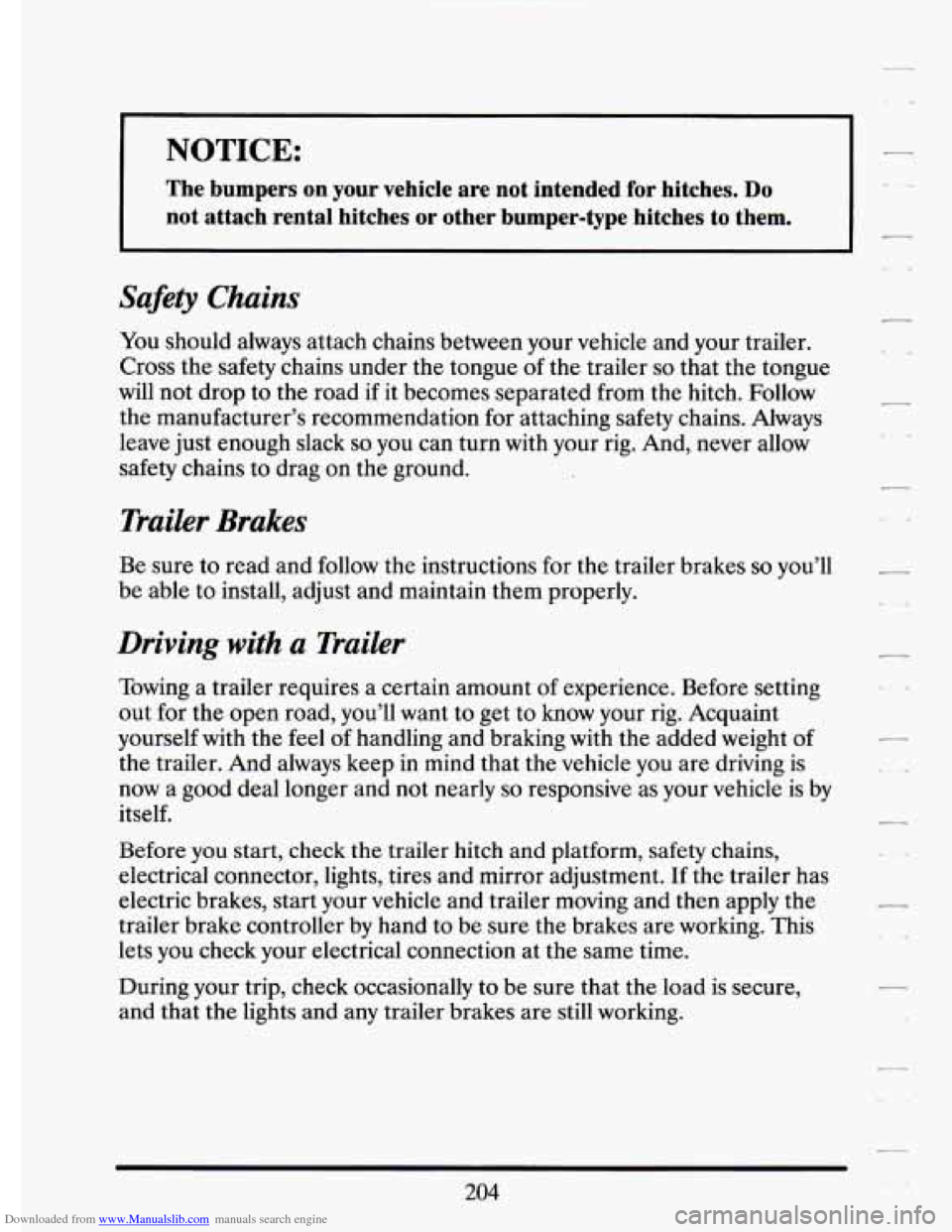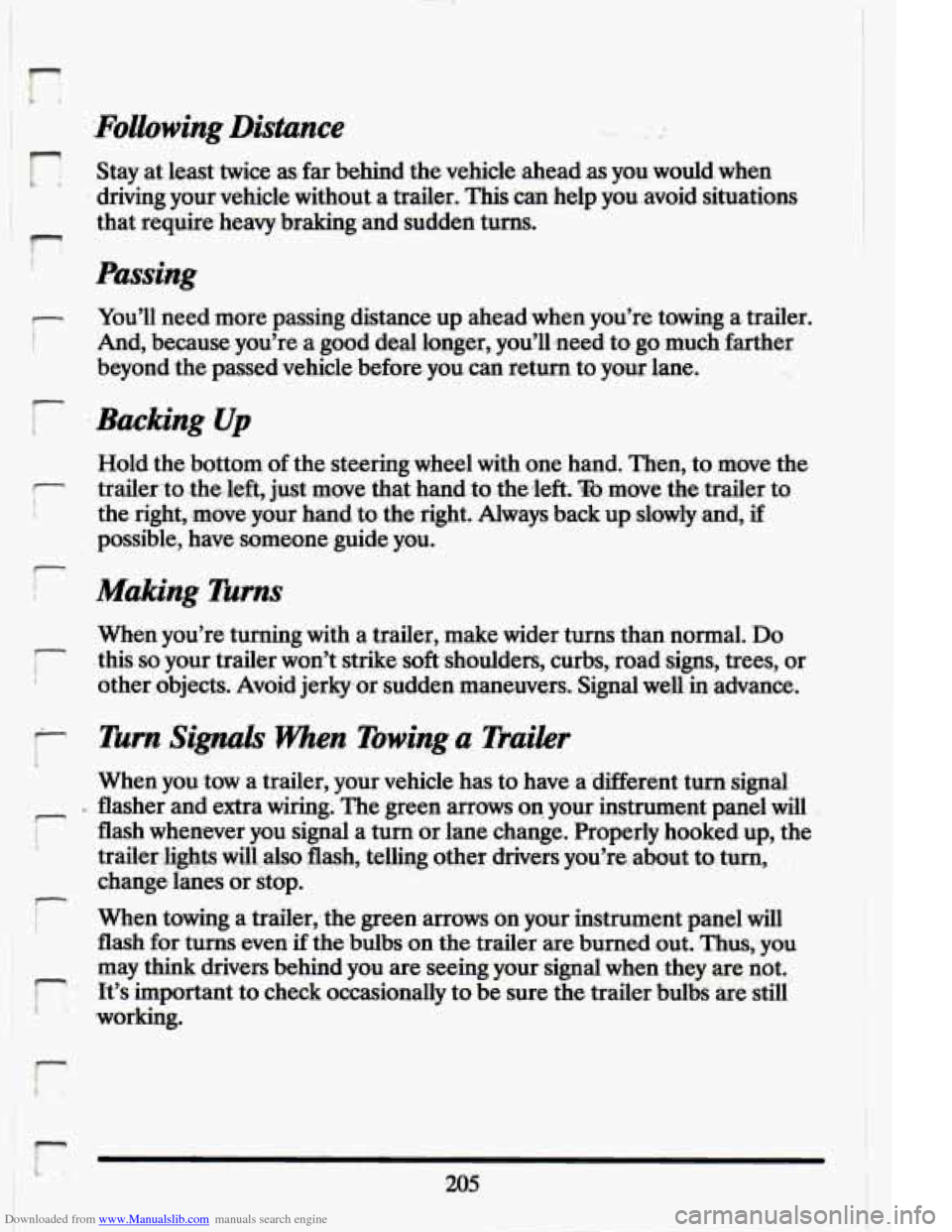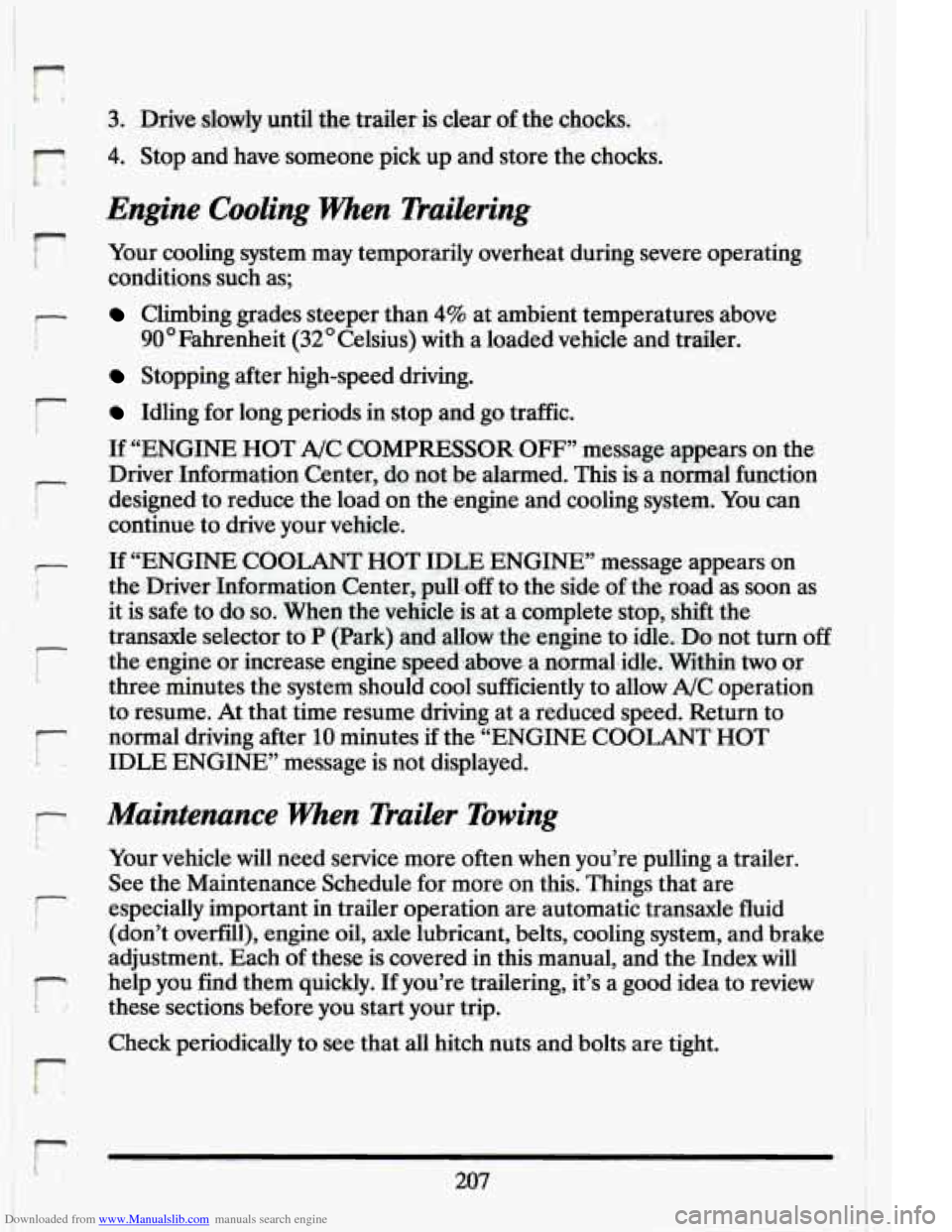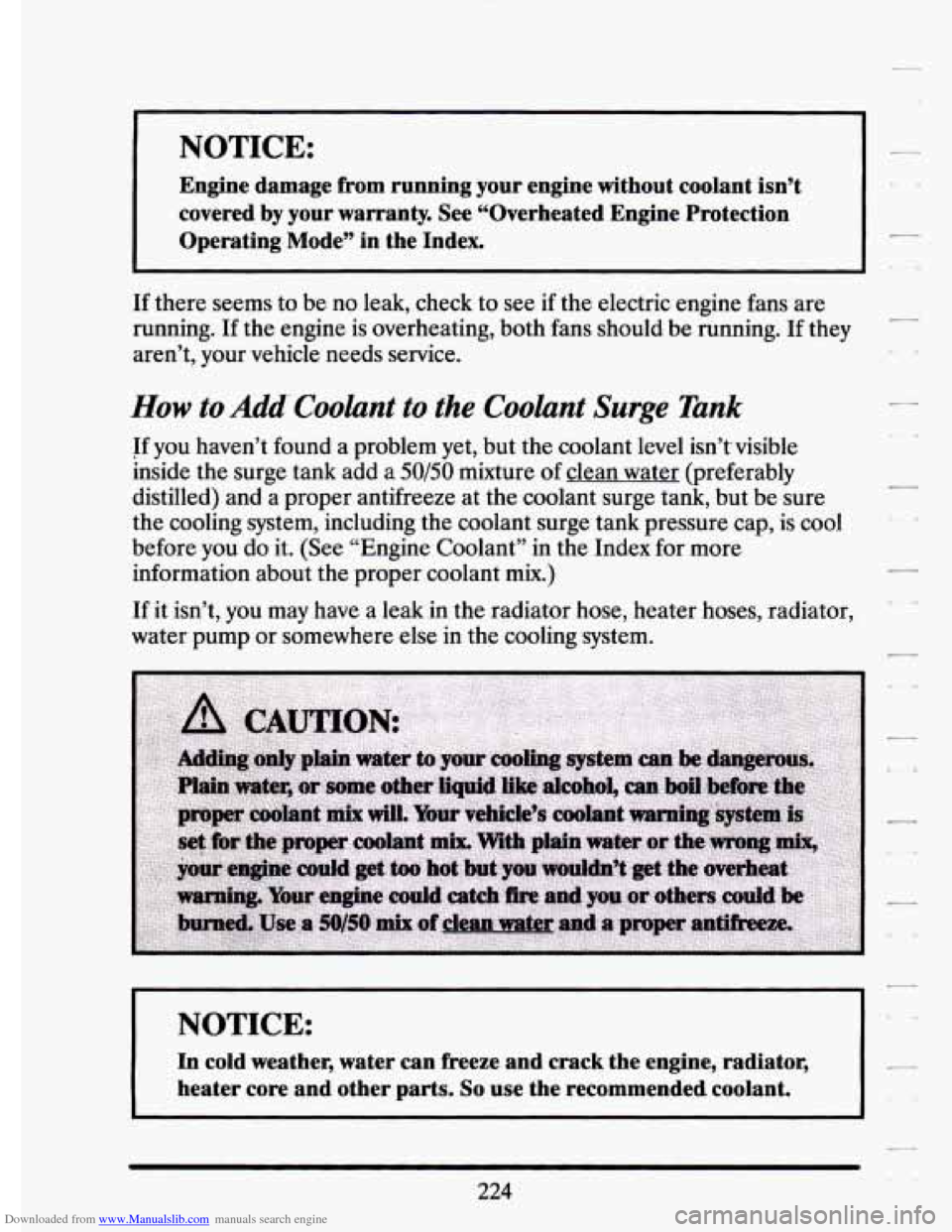Page 205 of 398

Downloaded from www.Manualslib.com manuals search engine n
r !
1- ,
r I
ii
P
I
- i
r
E‘
0 LiEhts: Are they all working? Are the lenses clean?
0 Tires: They are vitally important to a safe, trouble-free trip. Is the
tread good enough for long-distance driving? Are the tires all inflated
I
to the recommended pressure? 1 I
0 Weather Forecasts: What’s the weather outlook along your route?
Shodd you delay your trip a
short time to avoid a major storm
system?
0 Maps; Do you have up-to-date maps?
HIGHFKAYHWNOSIS
Is there actually such a condition as “highway hypnosis”? Or is it just
plain falling asleep at the wheel? Call it.highway hypnosis; lack
of
awareness, or whatever.
There
is something about an easy stretch of road with the same scenery,
along with the
hum of the tires on the road, the drone of the engine, and
the rush
of the wind against the vehicle. that can make you sleepy. Don’t
let it happen to you!
If it does, your vehicle can leave the road in less than
a second, and you could crash and be injured.
What can you do about highway hypnosis? First,
be aware that it can
happen.
Then here are some tips:
0 Make sure your vehicle is well ventilated, with a comfortably cool
interior.
0 Keep your eyes moving. Scan the road ahead and to the sides. Check
If you get sleepy, pull off the road into a rest, service., or parking area
your rearview
mirrors and
your instruments frequently.
and take a nap, get some exercise, or both. For safety, treat drowsiness
on the highway as an emergency.
i
193
Page 206 of 398
Downloaded from www.Manualslib.com manuals search engine HILL AND MOUNTMN ROADS
Driving on steep hills or mountains is different from driving in flat or
rolling terrain.
If you drive regularly in steep country, or if you’re planning to visit there,
here are some tips that can make your trips safer and more enjoyable.
Keep your vehicle in good shape. Check all fluid levels and a\
lso the
brakes, tires, cooling system and transaxle. These parts can work hard
on mountain roads.
Know how to go down hills. The most important thing to know is this:
let your engine do some of the slowing down. Shift to a lower gear
when you go down a steep
or long hill.
194
Page 216 of 398

Downloaded from www.Manualslib.com manuals search engine NOTICE:
The bumpers on your vehicle are not intended for hitches. Do
not attach rental hitches or other bumper-type hitches to them.\
-
Safety Chains
You should always attach chains between your vehicle and your trailer.
Cross the safety chains under the tongue of the trailer
so that the tongue
will not drop to the road
if it becomes separated from the hitch. Follow
the manufacturer’s recommendation for attaching safety chains. Alwa\
ys
leave
just enough slack so you can turn with your rig. And, never allow
safety chains to drag on
the ground.
Trailer Brakes
Be sure to read and follow the instructions for the trailer brakes so you’ll -
be able to install, adjust and maintain them properly. L:
Driving with a Trailer
Towing a trailer requires a certain amount of experience. Before setting
out for the open road, you’ll want to get to know your rig. Acquaint
yourself with the feel of handling and braking with the added weight of
the trailer. And always keep in mind that the vehicle you are driving is
now a good deal longer and not nearly
so responsive as your vehicle is by
itself.
Before you start, check the trailer hitch and platform, safety chains,
electrical connector, lights, tires and mirror adjustment. If the trailer has
electric brakes, start your vehicle and trailer moving and then apply the
trailer brake controller by hand to be sure the brakes are working. This
lets you check your electrical connection at the same time.
During your trip, check occasionally to be sure that the load is secure,
and that the lights and any trailer brakes are still working.
204
Page 217 of 398

Downloaded from www.Manualslib.com manuals search engine n
F- I
r
r i
I r’ j’ IL i
Folbwing Distance ~ ..
Stay at Least ,twice as far behind the vehicle ahead as you would when
driving your vehicie without a trailer.
This can help you.avoid situations
that require heavy braking and sudden turns.
,Passing
You’ll need more passing distance up ahead-.when you’re towing a. trailer.
And, because y0u’re.a good deal longer, you’ll need to go much farther
beyond the passed vehicle before you .can return to
your lane.
Backing Up
Hold the bottom of the steering wheel with one hand. Then, to move the
trailer ‘to .the- left, just move that hand
to the left. To move the trailer to
the right, .move -your hand
‘to the right. Always back up. slowly and, if
possible, have someone guide you.
Making nrns
When you’re turning with a trailer, make wider turns than normal. Do
.this so your trailer won? strike soft shoulders, curbs, road signs, trees, or
other .objects. Avoid jerky.or sudden maneuvers. Signal well
in advance.
Turn sigreals When Towing a Trailer
When you tow a trailer, your vehicle has to have a different turn signal
.= flasher and extra wiring. The green arrows on your instrument panel will f
J I flash, whenever you signal a turn or lane change. Properly hooked. up, the
trailer
l&hts will also flash, telling other drivers you’re about to turn,
change lanes or stop.
flash for turns even’if the.bulbs on the trailer are burned out. .Thus, you
may think drivers behind
you are seeing your- signal when they are not.
’ Et’s important to check occasionally to be sure the trailer. bulbs are still
r
i When towing a trailer; the green arrows on your instrument panel will
t! working.
205
Page 219 of 398

Downloaded from www.Manualslib.com manuals search engine r
F, 4. Stop and have someone pick up .and store the chocks.
Engine Cooling When Tru.ilering
r
I ? Your cooling system may temporarily overheat during severe operating
conditions such as;
Climbing grades steeper than 4% at ambient temperatures above
90” Fahrenheit (32O Celsius) with a loaded vehicle and trailer.
Stopping after high-speed driving.
I
r Idling for long periods in stop and go traffic. I
If ,“ENGINE HOT A/C COMPRESSOR OFF” message appears on. the
Driver Information Center, do.not be alarmed.
This is. a normal function
continue to drive’your vehicle.
the -Driver Information Center, pull
,off to the side of the road as, soon as
it is safe to do
so. When the vehicle is at a complete stop, shift the
transaxle selector to
P (Park) and allow the engine to idle.:Do not turn off
three minutes the system should cool sufficiently to allow A/C operation
to resume. At that time resume driving at a reduced speed. Return to
normal driving after
10 minutes if the “ENGINE COOLANT HOT
- designed. to reduce the load on the.engine and cooling system. You can
- If “ENGINE COOLANT HOT IDLE ENGINE” message.appears on
c
I the engine or increase engine speed.above a normalidle. Wit-hin two or
b- IDLE ENGINE” message is not displayed.
Maintenance When Trailer Towing
i L.
Your vehicle will need service more often when you’re pulling a trailer.
See the Maintenance Schedule for more on this. Things that are
(don’t overfill), engine oil,
axle lubricant, belts, cooling system, and brake
adjustment. Each
of these is covered in this manual, and the Index will
these sections before you start your trip.
i especially important in trailer operation are, automatic transaxle fluid
7 help you find them quickly. If you’re trailering, it’s a good idea to review
I
‘F
Check periodically to see that all hitch nuts and bolts are tight.
r 207
Page 223 of 398
Downloaded from www.Manualslib.com manuals search engine F
r- !.
f
f-
n I 1
f- i
If your battery has run down, you may want to use another vehicle and
some jumper cables to start your Cadillac. But please follow the steps
below to do it safely.
NOTICE:
Ignoring these steps could result in costly damage to your
vehicle that wouldn’t be covered by
your warranty.
nying to start your Cadillac
by pushing or pulling it won’t
work, and it could damage your vehicle.
TO JUMP START YOUR CADILLAC:
1. Check the other vehicle. It must have a 12-volt battery with a negative
ground system.
NOTICE:
I
If the other system isn’t a 12-volt system with a negative ground,
both vehicles can be damaged.
I
211
Page 226 of 398
Downloaded from www.Manualslib.com manuals search engine 6. Check that the jumper cables don’t have loose or missing insulation. If
they do, you could get a shock. The vehicles could be damaged, too.
Before you connect the cables, here are some things you should know.
Positive
(+) will go to positive (+) and negative (-) will go to negative
(-) or a metal engine part. Don’t connect (+) to (-) or you’ll get a
short that would damage the battery and maybe other parts, too.
-
C.
7. Connect the red positive (+) cable to the positive (+) terminal of the
8. Don’t let the other end touch metal. Connect it to the positive (+)
vehicle with the dead battery.
terminal
of the good battery.
9. Now connect the black negative (-) cable to the good battery’s
negative
(-) terminal.
214
Page 236 of 398

Downloaded from www.Manualslib.com manuals search engine I NOTICE:
Engine damage from running your engine without coolant isn’t \
covered
by your warranty. See “Overheated Engine Protection
Operating Mode” in the Index.
If there seems to be no leak, check to see if the electric engine fans are
running. If the engine is overheating, both fans should be running.
If they
aren’t, your vehicle needs service.
How to Add‘Coolant to the Coolant Surge Tank
If you haven’t found a problem yet, but the coolant level isn’tvisible
inside the surge tank add a
50/50 mixture of clean water (preferably
distilled) and a proper antifreeze at the coolant surge tank, but be sure
the cooling system, including the coolant surge tank pressure cap, is
cool
before you do it. (See “Engine Coolant’’ in the Index for more
information about the proper coolant mix.)
If it isn’t, you may have a leak in the radiator hose, heater hoses, radiator,
water pump or somewhere else in the cooling system.
c
NOTICE:
I
In cold weather, water can freeze and crack the engine, radiat\
or, -
heater core and other parts. So use the recommended coolant. L
_I
224